I finally got around to diagnosing and fixing the problem with the fluorescent lights in my garage (a bad ballast). Normally, that would have nothing whatsoever to do with gaming, but the light in question is the one that illuminates the part of the garage that doesn't actually contain automobiles. Instead, it currently contains a bunch of stuff that still hasn't been fully unpacked from our move, a bunch of scrap and junk that was there from before we moved, and a couple of tables that I hope will become my gaming space.
That last bit is the important part for my current project: terrain. I need more of it to have some decent games. I've got a couple of green flocked mats for most games, plus a blue felt one for air and sea battles. I also have a decent, but not overwhelming, supply of terrain for 15mm games (mainly Flames of War), but I lack much in the way of terrain for larger scales (mainly 40K).
I've been slowly trying to fix that problem by buying the occasional piece of GW terrain. So far, I've got a hill, a woods, an arcane ruins, the moonscape craters, and the new temple of skulls, but some have needed assembly, and they all need to be painted. Since my normal painting area is a Citadel Paint Station, and some of my terrain is as big as the paint station, I haven't been able to get to it before now. Now that I've got a couple of big tables with decent lighting, I've started to fix that.
My first project has been the simplest one: painting the Citadel Gaming Hill. A while back, in preparation for this, I purchased a Citadel Scenery Painting Pack. I'm sure it would have been significantly cheaper to just buy some brown and ochre craft paints at a hobby store, but I basically decided to pay for the convenience of getting everything in one package. In theory, there's enough paint, flock, and glue here to cover a 4'x6' Citadel Realm of Battle Gameboard, so I figured it would suffice to do several pieces of terrain.
There are some good and bad points to the pack. You do get a good size jar of brown paint, and a lot of scorched grass flock. The problem with both of them is how they come packaged. The pack comes with a 2" wide paint brush. The bottle of paint comes with a mouth that's smaller than 2". That means you're going to need a palette. The flock comes in a tightly sealed bag that is not re-sealable. You're going to spill some, and you're going to have to find another container to store what's left over. This would have been OK, if I were getting some sort of bulk deal on all of this, but I'm actually paying a premium over what I'd pay at the craft store, so it's a bit disappointing.
Still, the results aren't bad. The colors work well together. The included brush is going to get worn out fast when using it for drybrushing, but 2" brushes are cheap to buy at the hardware store. I haven't actually used the included flock, but it's the same as the flock you get in the Citadel tubs, which is what I'm using now (I'm just going to refill the tubs from the bags when they run out). Leaving out the time it took for the various stages to dry, it probably took less than an hour to finish.
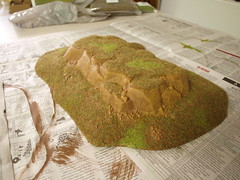
Next up, I'm going to do the moonscape craters using the same method. I'm also going to head to the craft store to get some different colors for doing the arcane ruins and the temple of skulls.
Longer term, I want to do some complete tables. Flocked mats are OK, but I've been wanting to do a full table for Flames of War for a while now. In preparation for that, I ordered a hot knife for cutting foam. After it gets here, I'll be heading to one of the DiY stores to get some foam board. I don't know that I'll start by doing a complete table, I may just do some smaller pieces first, but I want to eventually do three 2'x4' sections that will form a 6'x4' table representing the area around Kharkov in the summer of 1942. Mostly rolling hills with some wooded areas. I'll probably just model the rolling hills into the table, and maybe a road or two, while leaving room for the Battlefield in a Box river to be placed, or for some movable trees to be put down.
If that works out well, then I'll probably work on some other terrain tables as well, but that would be much further down the road.
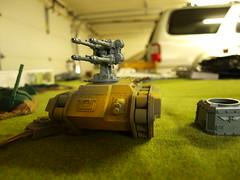
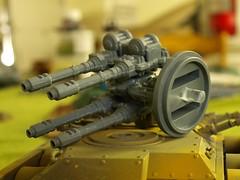
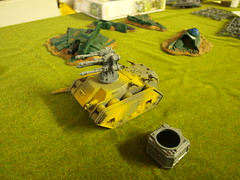

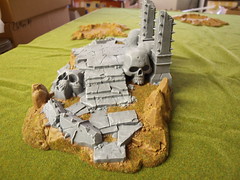



.jpeg)









